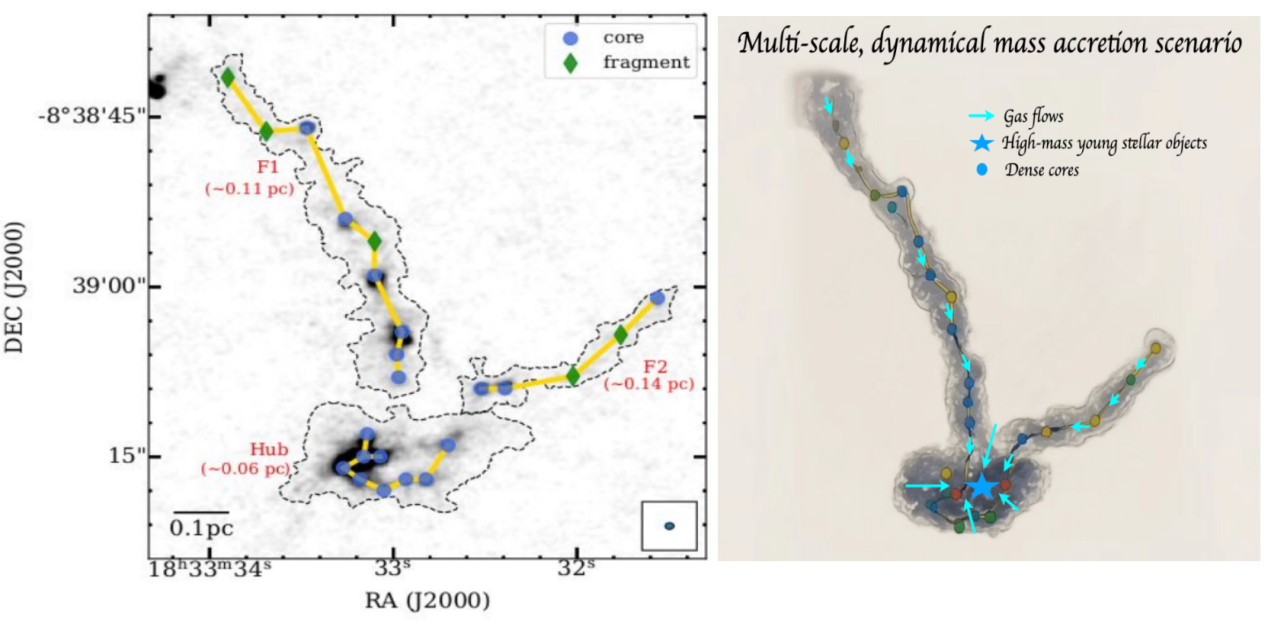ALMA High-Resolution Observations Reveal New Evidence for Bimodal Fragmentation and Multi-Scale Dynamical Mass Accretion in High-Mass Star Formation
Recently, a research team led by scientists from Yunnan University, the Shanghai Astronomical Observatory of the Chinese Academy of Sciences, and the National Astronomical Observatory of Japan, in collaboration with researchers from Japan, Mexico, the United States, Germany, Chile, and Taiwan, China, utilized high-resolution observational data from the Atacama Large Millimeter/submillimeter Array (ALMA) to reveal for the first time the coexistence of dual fragmentation modes and multi-scale dynamic material accretion in a "hub-filament system" (HFS) molecular cloud. This discovery provides groundbreaking evidence for understanding the formation mechanisms of massive stars. The findings were published in the astronomy journal Astronomy & Astrophysics on August 6, 2025.
Using the world’s most advanced (sub)millimeter interferometer, ALMA, the research team conducted ~3000AU resolution observations at the 1.3mm wavelength toward the HFS I18308 cloud, a high star-forming region with a textbook example of HFS morphologies (left panel, Figure 1). The team revealed dual fragmentation modes. Two hub-composing filaments (F1 and F2) exhibit a cylinder-like fragmentation mode, with the quasi-periodic core spacings regulated by the turbulence-dominated fragmentation mechanism. In contrast, the central hub clump shows a spherical-like fragmentation mode, with the core spacings regulated by gravity-dominated Jeans fragmentation mechanism. These findings challenge models predicting a single fragmentation mode across all density scales within molecular clouds (e.g., the global gravitational collapse model).
Moreover, the team did not find high-mass prestellar cores surpassing 30 solar masses; and instead all relatively low-mass cores show a systematic increase in mass and density with evolution. These observed facts support a multi-scale accretion scenario: low-mass prestellar cores form via Jeans fragmentation in the hub, collapse into intermediate-mass protostars, and grow into high-mass stars through hierarchical mass accretion from the filaments, hub clump, and cores (right panel, Figure 1).

Figure 1.Left: Morphological structure of the hub-filament system (HFS) in target region I18308, showing core spacing distribution. The HFS molecular cloud consists of two distinct filamentary structures (F1 and F2) and a central hub clump. Right: Artistic illustration of multi-scale dynamic mass accretion.
The first author of the paper is Zhen Lingmin, a master student at the School of Physics and Astronomy, Yunnan University. The corresponding authors are Associate Researcher Liu Hongli from Yunnan University, Researcher Lü Xing from the Shanghai Astronomical Observatory, and Dr. Cheng Yu from the National Astronomical Observatory of Japan. The research was funded by the National Key R&D Program of China, the National Natural Science Foundation of China, the Yunnan Fundamental Research Projects, the Yunnan "Xingdian Talent Support Plan" Youth Program, the CAS Strategic Priority Research Program, the Shanghai Natural Science Foundation, and the CAS "Light of West China" Program.
Link to the paper:https://doi.org/10.1051/0004-6361/202554634
Scientific contacts:
LIU Hongli:hongliliu2012@gmail.com;
LU Xing:xinglu@shao.ac.cn;
Cheng Yu: ycheng.astro@gmail.com
Download attachments: